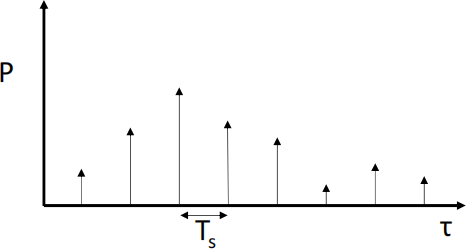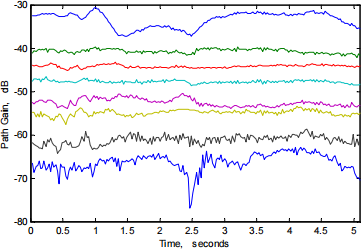关键词 > EENGM2510
EENGM2510 ADVANCED MOBILE RADIO TECHNIQUES 2023
发布时间:2024-05-16
Hello, dear friend, you can consult us at any time if you have any questions, add WeChat: daixieit
EENGM2510
ADVANCED MOBILE RADIO TECHNIQUES
May/June 2023
Q1 (a) What information is required to be known at the receiver in order to compute the tap coefficients of a Linear Transverse Equaliser (LTE) via a Zero Forcing (ZF) algorithm? (1 mark)
What challenges are associated with obtaining this information and executing the required computation? (2 marks)
(b) What information is required to be known at the receiver in order to compute the tap coefficients of an LTE via a Minimum Mean Square Error (MMSE) algorithm? (4 marks)
(c) What simplifications and/or approximations enable the Least Mean Squares (LMS) algorithm to avoid the matrix computation that would be required for a true Steepest Descent adaptation? (3 marks)
Q2 (a) With the aid of a diagram, sketch and label the frequency spectrum and associated time dynamics of a Frequency Hopping (FH) Spread Spectrum communication system. Label the data bandwidth and the overall spectrum content on your diagram. (1 mark)
Further explain how a pseudo random sequence generator can be applied to obtain FH operation. (1 mark)
(b) Assuming a Direct Sequence (DS) Spread Spectrum receiver, explain how synchronised de-spreading will allow data recovery of the transmitted information from a desired transmitter. (2 marks)
(c) Explain how Space Division Multiple Access (SDMA) can offer wireless multiplexing. (1.5 marks)
What are the core systems components. (1.5 marks)
(d) What is meant by the term Channel Reciprocity in a wireless access system exploiting the spatial domain? (2 marks)
Explain how this can be most effectively applied in the case of a Massive MIMO air interface. (1 marks)
Q3 (a) Draw a diagram of a Decision Feedback Equaliser (DFE). (1 mark)
Identify the ‘cursor’ tap on your diagram. (1 mark)
Identify on your diagram the part of the DFE which is distinct from the structure of a Linear Transverse Equaliser (LTE). (1 mark)
Explain in words the difference between the symbols stored in the memory of the feedforward and feedback sections of the DFE. (1 mark)
(b) What parameter of the expected radio channel determines the number of taps required in the DFE? (1 mark)
(c) Explain how the DFE achieves superior performance to the LTE. (1 mark)
(d) For a system which uses a DFE and operates over a channel with the example average channel impulse response shown in Figure Q3, estimate the number of taps required in each of the feedforward and feedback sections of the DFE. For each of these values, indicate whether the number is exact or an approximation and explain why this is the case. (3 marks)
(e) When designing a system that uses Orthogonal Frequency Division Multiplexing (OFDM), what parameter of the expected radio channel should a communications engineer take into account when specifying the maximum number of sub-carriers? (1 mark)
(f) Explain the benefits that a Guard Interval (GI) achieves when implemented in OFDM systems. Your answer should make reference to the impact that the use of a GI has upon the frequency domain equalisation process. (3 marks)
(g) Explain the cost associated with using a Guard Interval and quantify this cost as an efficiency term. On this basis, explain how this efficiency factor affects the minimum number of sub-carriers used by an OFDM system. (2 marks)
(h) For a system which uses OFDM and operates over a channel with the example average channel impulse response shown in Figure Q3, suggest the minimum number of sub-carriers the system should use. (1 mark)
(i) For a system operating over the same expected channel, if the maximum number of sub-carriers (identified according to the criteria in Q3e) is 80, determine a suitable Fast Fourier Transform size for the system to use. (1 mark)
(j) If the system bandwidth is 20MHz and the correlation bandwidth of the expected channel is 2.5MHz, determine a suitable spacing of pilots in a comb pattern to facilitate continuous channel estimation. Calculate the bandwidth efficiency cost of implementing this pilot pattern. (2 marks)
(k) Given your answers to Q3d and Q3i, compare the relative computational complexity of implementing a receiver which uses either a DFE or OFDM. You may neglect the computational complexity of any Fourier Transforms. (1 mark)

Figure Q3: Example Average Channel Impulse Response
Q4 (a) (i) Carefully explain how long pseudo random sequences in a direct sequence spread spectrum (DS-SS) wireless system can be applied to yield multiple user access. List one disadvantage of this methodology and suggest how this can be solved. (1 mark)
(ii) For a direct sequence code division multiple access (DS-CDMA) such as the Global Positioning System (GPS) satellite navigation system, explain why it is necessary to search both code and frequency domains in order to obtain spreading code synchronisation. (1 mark)
(iii) Explain how an Early-Late Gate Correlator can avoid false code synchronisation in a DS-CDMA receiver. (2 marks)
(b) (i) Briefly explain 2 reasons why 3G Wideband CDMA uses a higher channel bandwidth than Qualcomm’s IS95 standard. (1 mark)
(ii) Explain what is meant by Soft Handover in DS-CDMA and the advantages that this offers. (1 mark)
(iii) Carefully explain with the aid of diagrams (hint: show signal strength versus distance) why ‘add’ and ‘drop’ thresholds and timers are necessary for soft handover. (2 marks)
(c) (i) Explain how a conventional (ie. non massive) Multiple-Input Multiple-Output (MIMO) antenna wireless system can offer an increased Shannon capacity when compared to a single antenna system. Derive a mathematical model to further explain this phenomenon. (4 marks)
(ii) For a MIMO enabled wireless device operating under weak fading channel conditions, what form of MIMO signal processing should be applied? Explain how such a scheme could be implemented. (2 marks)
(iii) Figure Q4 shows the time variation of the channel gains for an 8 x 8 MIMO indoor system as the user moves with the receiving array. Explain how the optimum channel capacity could be obtained and what information needs to be shared for this to happen. (2 marks)

Figure Q4
(d) (i) What are the key physical (equipment) attributes of a Massive MIMO (MaMIMO) system. Carefully explain what the User Gram Matrix indicates about the spatial multiplexing conditions of a MaMIMO channel. Include a sketch to help illustrate your answer. (2 mark)
(ii) List 2 reasons likely to give rise to poor spatial multiplexing performance in a MaMIMO deployment. Suggest one potential solution to address one of the issues listed. (1 mark)
(iii) For a timing varying (eg. vehicular) Ma-MIMO scenario, explain how the channel coherence time varies between 16 and 128 element base-station array sizes. Also, give a physical explain action for this phenomena. (1 mark)

